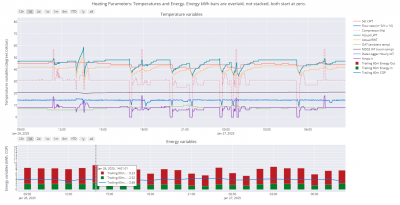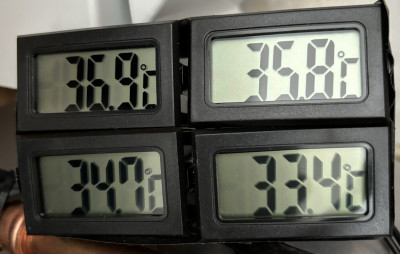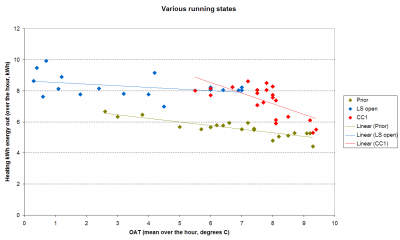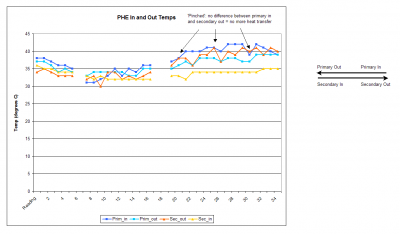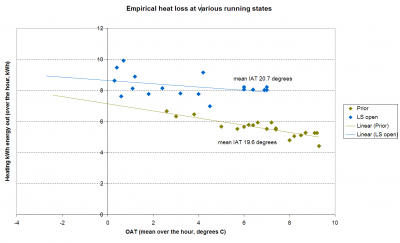@cathoderay this is great news. I'm pleased we're getting somewhere. There's a noticeable step change in the power output starting with the 18:00 result.
Like you said, some housekeeping:
You've got all the valves open on the secondary circuit and the pump is running on it's maximum curve, CC3.
Like you said, at this point, if you start to adjust the lock shield valves in anyway you will reduce the total flow in the secondary circuit and be back where you started.
There is another test we can do to prove it's the flow rate in the secondary circuit that's causing the issue. If you slow the pump down to the CC1 curve, your heat pump power should drop down below the 8.4kW we had at the beginning. Of course your house will end up cold so this might not be a pleasant thing to do.
If slowing the pump down drops the ASHP power output it confirms we need to get more flow on the secondary side to get more power.
The easiest way to do that would be to fit a bigger pump. I believe the one you have is 1.5" connections and 130mm "flange to flange". The only pump I've found that's that physical size but larger head/flow is this one:
https://wilo.com/gb/en/Products/en/products-expertise/wilo-stratos-pico/stratos-pico-25-0-5-8-130
(I have no affiliation with Wilo and I have not read the entire internet for heating pumps. I just know the Wilo website is easy to use).
Regards
Bob
Posted by: @bobtskutterThere is another test we can do to prove it's the flow rate in the secondary circuit that's causing the issue. If you slow the pump down to the CC1 curve, your heat pump power should drop down below the 8.4kW we had at the beginning. Of course your house will end up cold so this might not be a pleasant thing to do.
Will do this very shortly. I can always turn it back up to CC3!
Midea 14kW (for now...) ASHP heating both building and DHW
Posted by: @bobtskutterThere is another test we can do to prove it's the flow rate in the secondary circuit that's causing the issue.
I set the secondary circulating pump to CC1 at 1120 yesterday, and the result has been interesting:
All the lock shield valves are still fully open. I haven't changed anything else, the only variable that is free to change is the outside air temperature (OAT). Observations:
1. the heat pump energy out remains unclamped. The trailing 60 minute energy out at 1400 was 9.23kW, higher than anything ever recorded while the system was balanced (ie lock shields closed as needed to balance radiators).
2. the OAT was rather steady, between 6 and ten degrees. The is the typical steady state running range of OATs, and sure enough there are very few cycles, I count seven excluding the DHW spike at 1300.
3. The indoor air temperature (IAT) has been consistently higher than normal, and higher than my preferred IAT (21 vs 19 degrees). There is scope to reduce my weather compensation curve to get lower leaving water temperatures.
4. The primary water circulating pump flow rate remains very steady. The dips that do occur happen when the heat pump cycles. I am not sure what their significance is, if any.
5. The COP throughout has been an acceptable 3-4. It is possible lowering the leaving water temperature by a couple of degrees or so may increase it a bit.
Our hypothesis was that reducing the the secondary pump curve from CC3 to CC1 would limit the maximum amount of energy out (because the secondary circuit couldn't shift it fast enough. This hasn't happened. My tentative conclusion is that the balanced (partially closed) lock shield valves created a substantial resistance. Opening them then removed enough resistance to mean that even CC1 could provide enough flow for the system to be able to shift a lot of energy.
Despite the radiators being unbalanced (the two at the ends of the long pipe runs are noticeably cooler), the room temps are all pretty much OK. The warmest room (22 degrees) is the room where I have my PC and router, which are both mini radiators on their own account, as indeed I am, while the two coolest rooms (18 degrees) are the ones at the end of the long pipe runs, living room and main bedroom. The rest are at 20-21 degrees. I suspect there is not inconsiderable air flow between the various rooms, doors are all open, and it is still an old leaky building, and this helps to even out temperatures.
The most sensible working solution may be to stay on CC1, and just live with these minor variations. I will lower the weather curve by 2 degrees shortly, and see what happens then.
Midea 14kW (for now...) ASHP heating both building and DHW
This is very interesting,
I also have reduced my pump speed (same grundfos pump as you) to CC2 to try and reduce noise it seems to have made absolutely no difference to how warm my house is (I still have 1 blocked cold radiator either way)
Heat pump flow is still 0.53m³/h borderline error but I have not had a error for a little while.
COP of about 3.7 over last 3 days not the best but acceptable
Bizarre bits of kit these 🤣
@cathoderay It's great your house is now getting too warm, we're making progress.
It looks to me as though the average ASHP power is higher with the pump at CC3 than at CC1 - but I'm only looking at the trends, you could work it out numerically with your data. If you can record enough data at CC3 and then at CC1 you can filter the data to only look at power outputs when the OAT is, say, 0C to 5C.
Reducing the LWT will defiantly help the COP but please be carefull that the combination of low flow on the secondary side (CC1) and low LWT doesn't cause your PEX to pinch again. Do you understand what this term means? I can (try to) provide more explanation if necessary.
If you added digital temperature indicators to the pipework around the PEX you'd be able to take readings quickly. You can get packs of 4 from a well know website for about £10.
Regards
Bob
Toodles, heats his home with cold draughts and cooks food with magnets.
@bobtskutter - as ever, thanks.
Posted by: @bobtskutterIt looks to me as though the average ASHP power is higher with the pump at CC3 than at CC1 - but I'm only looking at the trends, you could work it out numerically with your data. If you can record enough data at CC3 and then at CC1 you can filter the data to only look at power outputs when the OAT is, say, 0C to 5C.
I can go one further, plot OAT vs kWh out for the various running states. Not a lot of data so far but here we go:
Prior = previous running state, ie CC3 and lock shields in use (balancing rads).
LS Open = still on CC3, lock shields fully open.
CC1 = CC1 with lock shields still fully open.
All are on the previous higher WCC curve, before I lowered it. CC1 is the odd one out, from what I have so far it looks like it will out-strip CC3 at lower OATs! It also has only a limited OAT range in the data. Nonetheless it is clear in this collection of small data sets that CC1 with lock shields open does better than CC3 with lock shields in service. The Prior (CC3, lock shields in service) vs LS Open (CC3, lock shields open) contrast is stark.
The very few data points from the lowered weather curve + CC1 + lock shields fully open are all over the place so I have omitted them (they become clutter). I will add them when I have more data.
This is of course a preliminary shapshot, more data is needed across the board.
I do know about those digital thermometers (and thanks @toodles for the photo) but they require manual reading, albeit it I could do it by setting them up so they are all visible and then taking photos once a minute for ten minutes. What that might do to my HDHD (Heatpump Deficit Hyperactivity Disorder) I hate to think!
Midea 14kW (for now...) ASHP heating both building and DHW
@bobtskutter heat pump geekery at its finest 😂
Get a copy of The Ultimate Guide to Heat Pumps
Subscribe and follow our YouTube channel!
Posted by: @cathoderayThe warmest room (22 degrees) is the room where I have my PC and router, which are both mini radiators on their own account, as indeed I am, while the two coolest rooms (18 degrees) are the ones at the end of the long pipe runs, living room and main bedroom. The rest are at 20-21 degrees.
Would bigger emitters compensate for the lower water temperature in the cooler rooms? Something extra in the living room might be sufficient as some heat will move up to the bedroom.
Posted by: @bobtskutterI find myself hoping for cold weather
A well recognised symptom of HDHD (Heatpump Deficit Hyperactivity Disorder). CBT (cognitive behavioural therapy) can sometimes help.
Posted by: @johnrWould bigger emitters compensate for the lower water temperature in the cooler rooms? Something extra in the living room might be sufficient as some heat will move up to the bedroom.
Possibly, but it has to be said the living room radiator is a large K3, making it larger or fitting another radiator will start upsetting the aesthetics of the room. The same applies to the main bedroom. I do agree any extra heat in the living room will mean some of it will find itself in the room above.
Posted by: @bobtskutterReducing the LWT will defiantly help the COP but please be carefull that the combination of low flow on the secondary side (CC1) and low LWT doesn't cause your PEX to pinch again. Do you understand what this term means? I can (try to) provide more explanation if necessary.
I think so.It happens when the temperature difference between the primary in and secondary out gets squeezed (pinched) to the point where there isn't enough difference to cause (drive) any heat transfer between the two circuits. Here's an annotated version of the chart in the PHE temps spreadsheet I posted earlier:
The only way of spotting this is to have simultaneous temperature readings of the PHE in and out connections. I'll do some manual IR thermometer readings later.
@jamespa - I've been wondering what implications these findings have for our empirical heat loss methods. What I think it means is you have to pay very close attention to the IAT. I have two heat loss curves in the in the recent data, one with the lock shields choking the system a bit, and the other with the lock shields fully open:
They give different heat losses at design OAT (-2 degrees), ~7.5 and ~8.8 kWh, but that is because the mean IAT was different. Any empirical heat loss should always state the mean IAT to which it applies.
Midea 14kW (for now...) ASHP heating both building and DHW
- 26 Forums
- 2,364 Topics
- 53.6 K Posts
- 238 Online
- 6,027 Members
Join Us!
Worth Watching
Latest Posts
-
RE: Speedcomfort radiator fans
Thats true, but having tried (and succeeded) in constru...
By JamesPa , 5 minutes ago
-
I see this thread as other reasons to be positive about...
By Deltona , 8 minutes ago
-
RE: Solis S6-EH1P8K-L-PLUS – Why I Chose It and What I’ve Learned So Far
@bash brilliant, thanks for the feedback
By energy9165 , 2 hours ago
-

RE: Setback savings - fact or fiction?
The OpenWeatherMap API provides plenty of historical da...
By Majordennisbloodnok , 2 hours ago
-

RE: Heat Pump Heats the House… But It’s Not Cosy. Emitter Changes or System Tweak?
@alastair There I was, feeling grumpy, he said “Cheer u...
By Toodles , 4 hours ago
-
RE: Grant Aerona: Is there a setting to keep the 2-port valve open during pump blockade
Depends on OAT. Mine cycles at OAT>10 and of course...
By JamesPa , 5 hours ago
-
RE: New Fogstar 15.5kWh upright solution
@transparent My conclusion is as you have noted, tha...
By Bash , 6 hours ago
-

That makes sense to me,although we don't know what the ...
By Transparent , 8 hours ago
-
RE: Mitsubishi Ecodan R290 10kW performance
And to you too. Wishing you a very enjoyable festive s...
By Sheriff Fatman , 8 hours ago
-

RE: External pipework insulation
They do? But that isn't apparent from the photos we'r...
By Transparent , 10 hours ago
-
RE: My Powerwall 3 Consumes 3-4 kWh/Day in Self-Consumption: Is This Normal?
@editor Thank you so much for looking into this for me ...
By Caron , 11 hours ago
-

RE: Say hello and introduce yourself
@velcro welcome to the forums. Please feel free start a...
By Mars , 1 day ago
-
Daikin EDLA11D3V3 DHW Settings
I have a newly installed EDLA11D3V3 which I'm still get...
By Velcro , 1 day ago
-

RE: Need Help Optimising My Rushed ECO4 Install: 12kW Bosch Heat Pump
Hi @mickamills . Welcome to the forum. It sounds like...
By bontwoody , 1 day ago
-
RE: Midea ASHP – how to set weather compensation
@curlykatie did you get sorted with this?
By MickaMills , 1 day ago
-
RE: Octopus Cosy Heat Pump Owners & Discussion Thread
The FT levels off at either the set point OR the minimu...
By AndrewJ , 2 days ago
-
RE: MyVaillant Connect Regular Disconnect
Thanks. Yes, if the time is consistently 11pm every nig...
By buckwem , 2 days ago
-
RE: Who's your electricity provider and what's your tariff?
@transparent Thanks, this helps. Could it be that St...
By Batpred , 2 days ago

